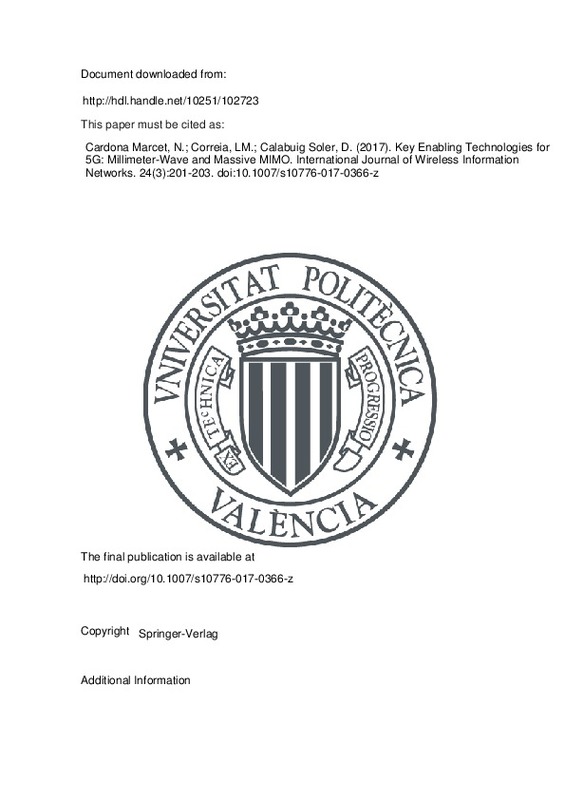JavaScript is disabled for your browser. Some features of this site may not work without it.
Buscar en RiuNet
Listar
Mi cuenta
Estadísticas
Ayuda RiuNet
Admin. UPV
Key Enabling Technologies for 5G: Millimeter-Wave and Massive MIMO
Mostrar el registro sencillo del ítem
Ficheros en el ítem
| dc.contributor.author | Cardona Marcet, Narciso
|
es_ES |
| dc.contributor.author | Correia, Luis M.
|
es_ES |
| dc.contributor.author | Calabuig Soler, Daniel
|
es_ES |
| dc.date.accessioned | 2018-05-27T04:17:09Z | |
| dc.date.available | 2018-05-27T04:17:09Z | |
| dc.date.issued | 2017 | es_ES |
| dc.identifier.issn | 1068-9605 | es_ES |
| dc.identifier.uri | http://hdl.handle.net/10251/102723 | |
| dc.description.abstract | [EN] 5G wireless networks are expected to operate with orders of magnitude higher performance than the current 4G deployments. The demand for 5000 times higher data rates leads to the necessity of finding new techniques to increase spectral efficiency and of exploring new frequency bands above 6 GHz. It has been proved that from UHF up to C band, a significant increase in system spectral efficiency can be reached through various techniques, such as Coordinated Multi-Point (CoMP), Massive Multiple-Input-Multiple-Output (MIMO), and interference management and cancellation; still, the resulting performance will not cope with the full expectations of IMT-2020 and 5G-PPP requirements for 5G networks, mainly in terms of offering 10 Gbps peak data rates with connection densities of 100 k¿1 M devices/km2. To overcome this limitation, the future architecture of such 5G networks is being defined to be deployed on small cells and to use higher frequency bands, such as super high frequency (SHF, 3¿30 GHz) or extremely high frequency (EHF, 30¿300 GHz), also referred as to centimeter and millimeter wave bands, respectively. | es_ES |
| dc.language | Inglés | es_ES |
| dc.publisher | Springer-Verlag | es_ES |
| dc.relation.ispartof | International Journal of Wireless Information Networks | es_ES |
| dc.rights | Reserva de todos los derechos | es_ES |
| dc.subject | Mobile Communications | es_ES |
| dc.subject | Massive MIMO | es_ES |
| dc.subject | 5G | es_ES |
| dc.subject | Millimiter-wave | es_ES |
| dc.subject | Radiocommunications | es_ES |
| dc.subject.classification | TEORIA DE LA SEÑAL Y COMUNICACIONES | es_ES |
| dc.title | Key Enabling Technologies for 5G: Millimeter-Wave and Massive MIMO | es_ES |
| dc.type | Artículo | es_ES |
| dc.identifier.doi | 10.1007/s10776-017-0366-z | es_ES |
| dc.rights.accessRights | Abierto | es_ES |
| dc.date.embargoEndDate | 2018-10-01 | es_ES |
| dc.contributor.affiliation | Universitat Politècnica de València. Departamento de Comunicaciones - Departament de Comunicacions | es_ES |
| dc.contributor.affiliation | Universitat Politècnica de València. Instituto Universitario de Telecomunicación y Aplicaciones Multimedia - Institut Universitari de Telecomunicacions i Aplicacions Multimèdia | es_ES |
| dc.description.bibliographicCitation | Cardona Marcet, N.; Correia, LM.; Calabuig Soler, D. (2017). Key Enabling Technologies for 5G: Millimeter-Wave and Massive MIMO. International Journal of Wireless Information Networks. 24(3):201-203. doi:10.1007/s10776-017-0366-z | es_ES |
| dc.description.accrualMethod | S | es_ES |
| dc.relation.publisherversion | http://doi.org/10.1007/s10776-017-0366-z | es_ES |
| dc.description.upvformatpinicio | 201 | es_ES |
| dc.description.upvformatpfin | 203 | es_ES |
| dc.type.version | info:eu-repo/semantics/publishedVersion | es_ES |
| dc.description.volume | 24 | es_ES |
| dc.description.issue | 3 | es_ES |
| dc.relation.pasarela | S\351730 | es_ES |







![[Cerrado]](/themes/UPV/images/candado.png)

